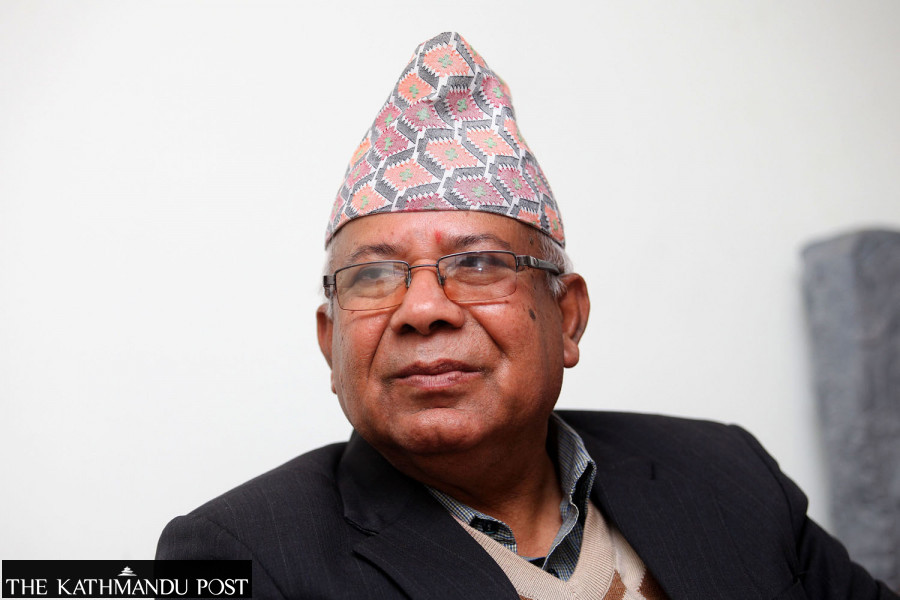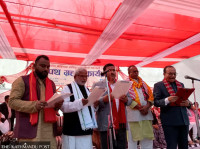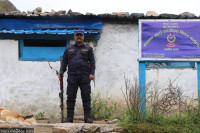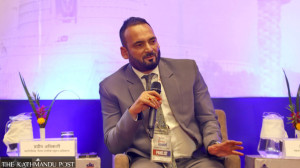National
Nepal’s indictment in graft reignites ‘policy decision’ debate
Not every Cabinet decision is a policy decision, say experts, backing the anti-corruption commission.
Binod Ghimire
The Commission for Investigation of Abuse of Authority (CIAA) on Thursday lodged a corruption case against former prime minister and CPN (Unified Socialist) chair Madhav Kumar Nepal for allowing the purchase and sale of land beyond the legal ceiling through his Cabinet.
Party leaders were quick to allege that the constitutional anti-graft body acted against Nepal at the behest of Prime Minister KP Sharma Oli. Rajendra Pandey, the Unified Socialist’s vice-chair, even claimed that no prime minister would be spared if Cabinet decisions—which he described as policy decisions—are subjected to corruption charges.
Backing the charge, CPN (Maoist Centre) chair Pushpa Kamal Dahal on Friday said a serious question has been raised about the CIAA’s intention.
“The CIAA has entered into the case involving Madhavji, even though it was clearly a policy-level decision,” he said, adding that the commission will have to respond to the matter.
The controversy has reignited discourse over what qualifies a “policy decision”.
Section 4 (2) of the CIAA Act says the commission would not conduct any investigation, inquiry, or take any action in relation to any policy decision collectively made by the council of ministers or any of its committees. Citing the same provision, the commission had long been refraining from chargesheeting the prime ministers in the corruption case.
Now, for the first time since 1990, the CIAA lodged a corruption case against Nepal for a Cabinet decision. The commission has primarily accused Nepal of facilitating Patanjali Yogpeeth and Ayurveda Company Nepal to purchase land beyond the legal ceiling in Nasikasthan Sanga, Mahendrajyoti of Kavrepalanchok district for company operations. And, then giving Cabinet approval to sell the land, which under the Land Act should have been confiscated and maintained as government or public property, two months after allowing for purchase.
While opposition leaders are critical to the move, the experts claim it to be a welcome decision. “The CIAA has finally dared it. It is a precedent-setting move,” Gauri Bahadur Karki, former chair of the Special Court, told the Post. “Decisions like allowing some companies to own land illegally can not be defined as policy decisions. Not all Cabinet decisions are policy decisions.”
Experts say policy decisions are taken when there are no laws to guide certain actions—for instance, procurement of relief items immediately during disasters. Also, decisions that are implemented at a national level and broader public good, are considered policy decisions.
But decisions intended to benefit certain individuals, institutions, or groups, such as in Patanjali’s case, cannot be called policy decisions. Those involved in such decisions must be held accountable, they say.
“The CIAA has made a decision that we had long advocated for,” Madan Krishna Sharma, chairperson of Transparency International Nepal, told the Post. “Sparing every type of Cabinet decision from corruption investigation puts the prime minister and the council of ministers above the law.”
Though the anti-corruption campaigners are encouraged by the commission’s move, they fear that the corruption charge could be limited to Nepal alone. “The case against Nepal should not be seen as selective. The CIAA must prove that it will book others as well,” said Sharma.
Over the years, there have been calls to clarify what constitutes a policy decision. In 1996, the Supreme Court had directed the government to define it.
As per the verdict by then-chief justice Surendra Prasad Singh and justices Keshav Prasad Upadhyaya, Laxman Prasad Aryal, Kedar Nath Upadhyay, and Udayaraj Upadhyaya, decisions taken ‘collectively’ by the Cabinet to fulfil promises made in the election manifesto constitute ‘policy decisions’.
In its 2018-19 Annual Report, the anti-graft commission also asked the government to define “policy decision” and draw a clear line between “policy decisions” and “administrative decisions” made through Cabinet meetings. However, the policy decisions are yet to be defined legally, though the State Affairs and the Good Governance Committee of the House of Representatives has reached a conclusion on the definition.
While finalising a provision in the bill to amend the CIAA Act, the committee has agreed that decisions that benefit only specific individuals or private institutions, in a manner that does not apply equally to the general public or that contradict publicly announced policies, shall not be considered as policy decisions. Likewise, decisions made outside the scope of the prevailing public procurement laws shall also not be deemed as policy decisions. “The CIAA can investigate such cases,” reads the agreed provision. The bill, however, is still under consideration in the House committee.
Karki said there are several instances where the Cabinet has made decisions that could have been taken by lower government agencies, to cover them as policy decisions to prevent them from the CIAA scrutiny. “I believe such practice would end now,” he said.
While criticising the CIAA’s move, opposition leaders claim that bringing the Cabinet under the commission’s scanner could scare the executive from even making necessary decisions. The experts, however, do not buy the argument claiming there is no reason to be scared of making the right decision. “I don’t buy the logic. There is no reason to be afraid of making decisions for the greater public good,” said Karki.




 19.12°C Kathmandu
19.12°C Kathmandu













%20(1).jpg&w=300&height=200)

